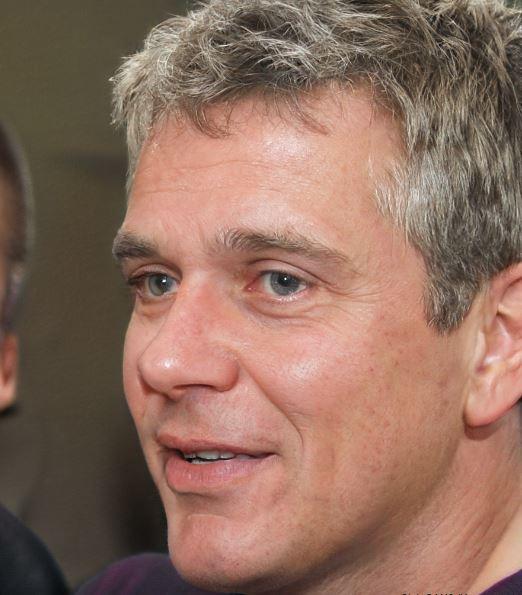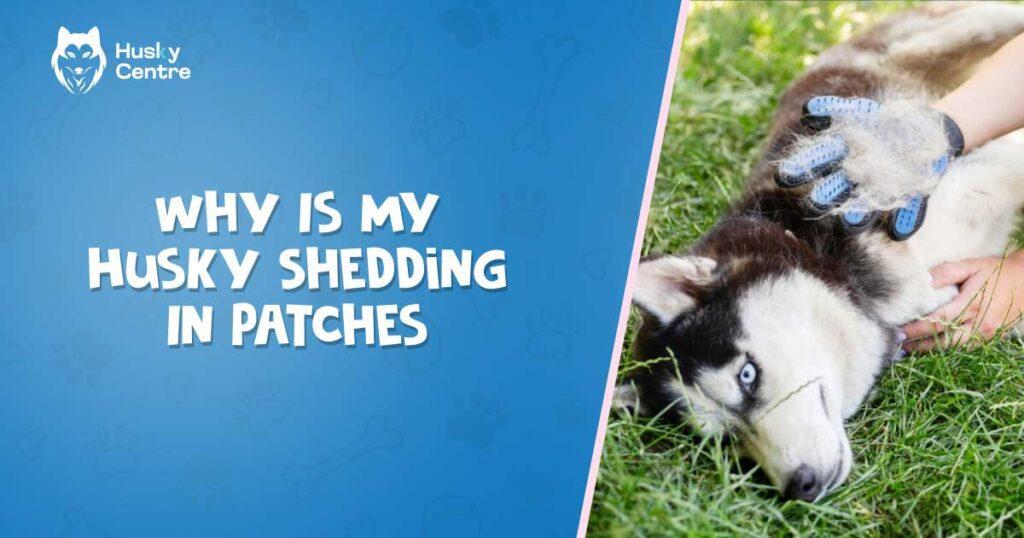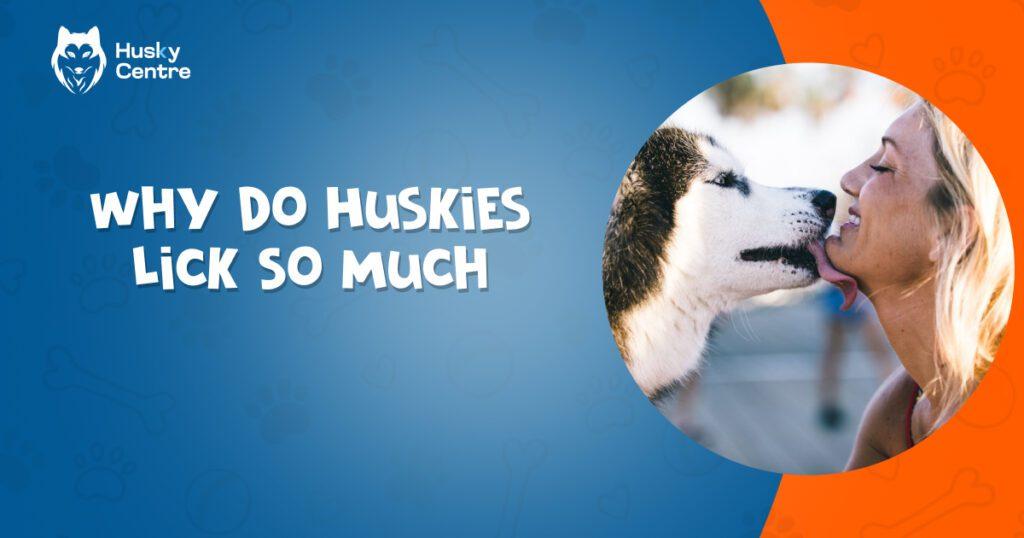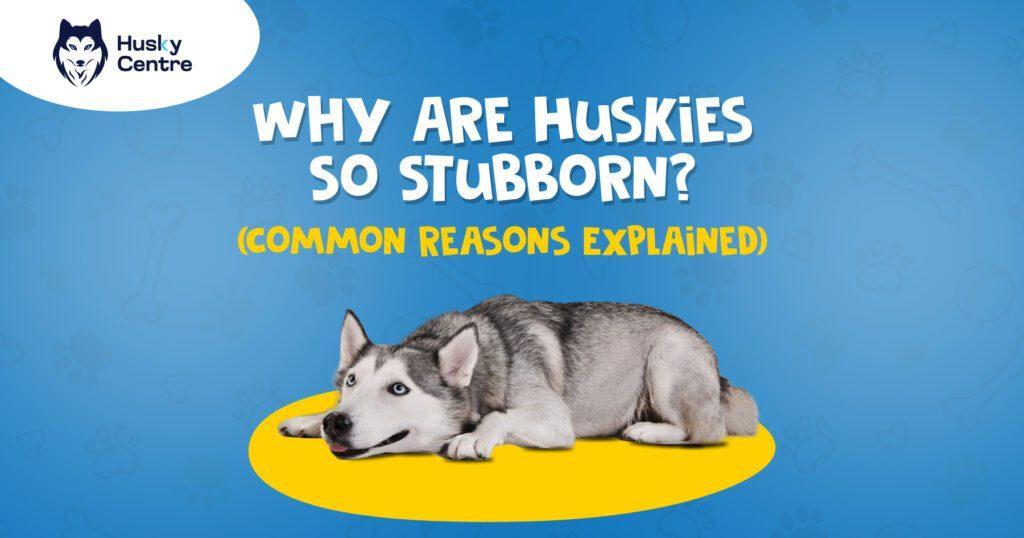Your Husky may be shedding in patches due to skin infections or parasites. Stress and hormonal imbalances can also cause uneven shedding.
Huskies are known for their thick double coats, which help them withstand cold climates. This coat undergoes regular shedding, often termed “blowing coat. ” Patchy shedding, however, is not typical and may indicate underlying health issues. Skin infections, such as fungal or bacterial infections, can cause hair loss in specific areas.
Parasites like mites or fleas also lead to uneven fur loss. Hormonal imbalances, including thyroid problems, can affect your dog’s coat. Stress, poor diet, or allergies can contribute to unusual shedding patterns. Monitoring your Husky’s overall health and consulting a veterinarian for proper diagnosis and treatment is crucial.
Normal Shedding Cycles In Huskies
Why is My Husky Shedding in Patches? Huskies are known for their thick and beautiful fur coats. But shedding in patches can worry many pet owners. Understanding the normal shedding cycles in Huskies helps you differentiate between regular and abnormal shedding.
Huskies shed their fur twice a year. This process, known as “blowing coat,” typically occurs in spring and fall. During these times, your Husky will lose large amounts of fur, making room for new growth. This is a natural and healthy process.
Why Do Huskies Shed More In Spring And Fall?
In spring, Huskies shed their thick winter coat to stay cool in warmer months. In fall, they shed their lighter summer coat to grow a thicker one for winter. This helps them regulate their body temperature throughout the year.
What Does Normal Shedding Look Like?
Normal shedding involves even hair loss across the body. You might notice clumps of fur around your home. This is completely normal and part of their natural shedding cycle.
How To Manage Normal Shedding?
To manage shedding, brush your Husky regularly. Use a high-quality brush designed for thick fur. Regular brushing helps remove loose fur and keeps their coat healthy. You can also bathe your Husky during shedding seasons to help remove excess fur.
Common Tools For Managing Shedding
| Tool | Purpose |
| Slicker Brush | Removes loose fur and detangles hair |
| Deshedding Tool | Reaches undercoat to remove loose fur |
| Comb | Helps detangle and remove small clumps |
Regular grooming and maintenance can keep your Husky’s coat looking healthy and minimize shedding around the home. Understanding the normal shedding cycles in Huskies ensures you know what to expect and how to manage it effectively.
Factors That Influence Shedding Patterns
Huskies are known for their thick, beautiful coats, but sometimes owners notice their furry friends shedding in patches. Understanding the factors that influence shedding patterns can help you address this issue effectively. In this section, we delve into the various elements that could be causing your Husky to shed in patches.
Health Conditions
Health issues can cause your Husky to shed in patches. Conditions like allergies, hormonal imbalances, and parasites are common culprits. Allergies, whether food-related or environmental, can lead to hair loss. Hormonal imbalances, such as hypothyroidism, can also affect the coat. Parasites like fleas and mites may cause intense itching and patchy shedding.
A poor diet can severely impact your Husky’s coat. Lack of essential nutrients can lead to patchy shedding. Ensure your Husky’s diet includes omega-3 fatty acids, vitamins, and minerals for a healthy coat. Consult your vet to choose the right dog food.
Stress And Anxiety
Stress can cause your Husky to shed in patches. Changes in environment, new family members, or even loud noises can make your dog anxious. Stress triggers the release of cortisol, which can affect the hair follicles and lead to patchy shedding.
Seasonal Changes
Huskies naturally shed more during certain seasons. Seasonal shedding often happens in spring and fall. While this is normal, excessive shedding in patches might indicate an underlying issue. Regular grooming can help manage seasonal shedding.
| Factor | Description |
| Health Conditions | Allergies, hormonal imbalances, parasites |
| Diet and Nutrition | Lack of essential nutrients |
| Stress and Anxiety | Changes in environment, new family members, loud noises |
| Seasonal Changes | Shedding more in spring and fall |
Skin Infections
Skin infections can also cause patchy shedding. Bacterial and fungal infections may lead to hair loss and inflammation. If you notice redness, swelling, or an unpleasant odor, consult your vet immediately.
Genetics
Genetics play a role in your Husky’s shedding patterns. Some Huskies may be more prone to patchy shedding due to their genetic makeup. Breeding practices can also influence coat health and shedding patterns.
Reasons For Shedding In Patches
Huskies are known for their beautiful, thick coats. However, if your Husky starts shedding in patches, it can be concerning. There are several reasons why this might happen. Understanding these can help you take better care of your furry friend. Let’s explore the main reasons for patchy shedding in Huskies.
Seasonal Shedding (blowing Coat)
Huskies have a double coat that helps them stay warm in winter and cool in summer. This coat changes with the seasons. Seasonal shedding, also known as “blowing coat,” is a normal process for Huskies. During this time, you may notice your Husky shedding in patches.
Here are some key points to understand seasonal shedding:
- Occurs twice a year: In spring and fall.
- Helps regulate body temperature: Shedding the old coat for a new one.
- Can last several weeks: Be prepared for increased grooming needs.
To manage seasonal shedding, follow these tips:
- Regular grooming: Brush your Husky daily to remove loose fur.
- Bathing: Use a gentle dog shampoo to help loosen the shedding fur.
- Diet: Ensure your Husky has a balanced diet to maintain a healthy coat.
Stress Or Anxiety
Huskies are sensitive dogs. Stress or anxiety can cause them to shed in patches. If your Husky is stressed, you might see more hair loss than usual.
Common causes of stress in Huskies include:
- Changes in routine: New family member, moving to a new home.
- Loud noises: Thunderstorms, fireworks.
- Separation anxiety: Being left alone for long periods.
Signs of stress in Huskies:
- Excessive barking or whining.
- Chewing or destructive behavior.
- Pacing or restlessness.
To help reduce your Husky’s stress:
- Provide a calm environment: Create a safe space for your dog.
- Spend quality time: Play and exercise with your Husky daily.
- Consult a vet: Seek professional advice if stress persists.
Health Issues Or Allergies
Health issues or allergies can also cause your Husky to shed in patches. It’s important to rule out any medical conditions.
Common health issues that lead to patchy shedding include:
- Skin infections: Bacterial or fungal infections.
- Parasites: Fleas, ticks, or mites.
- Thyroid problems: Hypothyroidism can lead to hair loss.
Allergies can also cause shedding:
- Food allergies: Certain ingredients can trigger reactions.
- Environmental allergies: Pollen, dust, or mold.
- Contact allergies: Reactions to grooming products or chemicals.
To address health issues or allergies:
- Visit the vet: Get a proper diagnosis and treatment plan.
- Medications: Follow prescribed treatments for infections or parasites.
- Dietary changes: Switch to hypoallergenic food if needed.
Regular check-ups and proper care can help keep your Husky’s coat healthy.
Environmental Factors
Huskies are known for their thick, double coats, which help them withstand cold climates. But sometimes, they may start shedding in patches. One primary reason for this could be various environmental factors. Understanding these factors can help you manage your Husky’s shedding and keep their coat healthy.
Temperature And Climate
Temperature and climate play a significant role in your Husky’s shedding patterns. Huskies are bred for cold environments, so they naturally shed more when exposed to warmer climates.
Key Points:
- In cold climates, their thick coats keep them warm, and shedding is minimal.
- In warmer climates, they shed more to stay cool.
Temperature fluctuations can also stress their coats, leading to patchy shedding. For example, sudden changes from hot to cold can make them shed unevenly.
| Climate | Shedding Pattern |
| Cold | Minimal Shedding |
| Warm | Increased Shedding |
| Fluctuating | Patchy Shedding |
Ensure your Husky stays in a stable environment. Avoid extreme temperature changes to prevent stress-induced shedding.
Indoor Vs. Outdoor Living Conditions
Where your Husky spends most of their time also affects their shedding patterns. Huskies living indoors experience different environmental factors compared to those living outdoors.
Indoor Huskies:
- Experience controlled temperatures, leading to less stress on their coats.
- May shed less overall but can still shed in patches due to artificial heating and cooling.
Outdoor Huskies:
- Face natural weather changes, leading to more shedding during seasonal transitions.
- May experience more stress on their coats due to varying humidity and exposure to elements.
Balancing indoor and outdoor time can help manage their shedding. Use grooming tools regularly to reduce shedding and keep their coat healthy.
Grooming Practices
Huskies are known for their beautiful double coats, but shedding can become a concern, especially when it occurs in patches. Understanding the right grooming practices can help manage and even prevent this issue. Consistent grooming not only keeps your Husky looking its best but also ensures its skin and coat are healthy.
Importance Of Regular Brushing
Regular brushing is crucial for maintaining a Husky’s coat. Brushing helps remove loose fur, dirt, and debris, which can prevent patchy shedding. Here are some key benefits:
- Prevents matting: Regular brushing keeps the fur tangle-free.
- Stimulates skin: Brushing improves blood circulation to the skin.
- Distributes natural oils: Spreads oils evenly, keeping the coat shiny.
For best results, brush your Husky at least three times a week. During shedding season, daily brushing may be necessary. Use a slicker brush for removing loose fur and an undercoat rake for deeper grooming. Consistency is key to managing shedding effectively.
Proper Techniques To Manage Shedding
Using the right techniques can make a big difference in managing shedding. Follow these steps for effective grooming:
- Start with the head: Begin brushing at the head, moving towards the tail.
- Brush in sections: Divide the coat into sections to ensure thorough grooming.
- Be gentle: Avoid pulling or tugging at knots to prevent skin irritation.
- Check for skin issues: Look for signs of skin problems like dryness or redness.
Incorporating these techniques into your regular grooming routine can help reduce patchy shedding and keep your Husky’s coat in top condition.
Using Deshedding Tools And Products
Deshedding tools and products can significantly aid in managing shedding. Some useful tools include:
| Tool/Product | Benefits |
| Undercoat Rake | Removes loose undercoat fur without damaging the top coat. |
| Slicker Brush | Detangles fur and removes debris effectively. |
| Deshedding Shampoo | Reduces shedding by strengthening the hair follicles. |
Use these tools and products consistently for the best results. Always choose high-quality tools and hypoallergenic products to avoid skin irritation. By incorporating these into your grooming routine, you can effectively manage and reduce your Husky’s shedding.
Diet And Nutrition
Is your Husky shedding in patches? Diet and nutrition could be key factors. A balanced diet ensures your Husky maintains a healthy coat. Poor nutrition often leads to patchy shedding, signaling underlying health issues. Understanding how diet impacts coat health and knowing which nutrients are essential can help keep your Husky’s fur shiny and thick.
Impact Of Diet On Coat Health
A Husky’s coat health is directly linked to its diet. Nutrient deficiencies can cause patchy shedding. Your dog’s coat reflects its overall health, and a poor diet often leads to dull, brittle fur and increased shedding.
Several factors show how diet impacts coat health:
- Protein Quality: High-quality protein is essential for fur growth. Low-quality protein can cause weak, thin fur.
- Omega-3 and Omega-6 Fatty Acids: These fatty acids keep the coat shiny and reduce inflammation. Lack of these can result in dry, flaky skin.
- Vitamins and Minerals: Specific vitamins like Vitamin E and Biotin play a role in maintaining a healthy coat. Deficiencies can cause hair loss and skin problems.
Consider the following table which summarizes the impact of poor diet on coat health:
| Nutrient Deficiency | Impact on Coat |
| Protein | Weak, thin fur |
| Omega-3 and Omega-6 | Dry, flaky skin |
| Vitamins and Minerals | Hair loss, skin problems |
Essential Nutrients For Skin And Coat
To ensure your Husky has a healthy coat, focus on providing essential nutrients. These nutrients support skin health and promote fur growth. Here are key nutrients to include in your Husky’s diet:
- High-Quality Protein: Chicken, fish, and lamb are excellent protein sources. They help build and repair fur tissue.
- Omega-3 and Omega-6 Fatty Acids: Found in fish oil, flaxseed, and certain meats. They keep the coat shiny and reduce inflammation.
- Vitamins:
- Vitamin E: Acts as an antioxidant, protecting skin cells.
- Biotin: Supports healthy fur and skin.
- Minerals:
- Zinc: Crucial for skin health and immune function.
- Iron: Helps carry oxygen to fur follicles, promoting growth.
Feeding your Husky a balanced diet with these nutrients ensures healthy skin and a thick, shiny coat. Proper nutrition is key to preventing patchy shedding and maintaining your Husky’s overall health.
When To Seek Veterinary Advice
Huskies are known for their beautiful, thick coats, but seeing your furry friend shedding in patches can be alarming. This unusual shedding can be a sign of underlying health issues. Understanding when to seek veterinary advice is crucial to ensure your Husky’s health and happiness.
If your Husky is shedding in patches, it might indicate a more serious issue. Here are some specific signs that it’s time to consult a vet:
Excessive Itching And Scratching
Is your Husky constantly scratching or biting at its skin? This behavior could mean a skin infection or parasites. A vet can diagnose and treat the problem effectively.
Red Or Inflamed Skin
Red, inflamed skin around the shedding patches can signal allergies or skin conditions. These conditions often require professional treatment to prevent further complications.
Open Sores Or Lesions
Open sores or lesions on the skin are serious signs. They can lead to infections and should be addressed by a vet immediately.
Unusual Odor
If the shedding areas have a bad smell, this could indicate a bacterial or fungal infection. Early treatment can prevent the infection from spreading.
Changes In Behavior
Look for changes in your Husky’s behavior. Lethargy, loss of appetite, or irritability can indicate that something is wrong. A vet visit can help identify the cause.
Persistent Shedding
If the patchy shedding persists for more than a few weeks, it’s time to seek professional advice. Prolonged shedding can be a symptom of more serious health issues.
| Symptom | Possible Cause | Action |
| Excessive Itching | Parasites or Skin Infection | Consult a Vet |
| Red, Inflamed Skin | Allergies or Skin Conditions | Seek Veterinary Advice |
| Open Sores | Infections | Immediate Vet Visit |
| Unusual Odor | Bacterial or Fungal Infection | Early Treatment Needed |
| Behavioral Changes | Underlying Health Issues | Professional Diagnosis |
| Persistent Shedding | Serious Health Issues | Veterinary Consultation |
Frequently Asked Questions
Why Is My Husky Losing Patches Of Fur?
Your husky might be losing fur due to allergies, parasites, infections, or hormonal imbalances. Consult a vet for diagnosis.
Why Is My Husky Shedding In Chunks?
Your husky sheds in chunks due to seasonal changes, stress, or poor diet. Regular grooming helps manage shedding.
What Months Do Huskies Shed The Most?
Huskies shed the most in spring and fall. This is when they blow their coat to prepare for seasonal changes. Regular grooming helps manage shedding.
Why Is My Husky Shedding So Bad Right Now?
Your husky is shedding heavily due to seasonal changes. Huskies shed their undercoat in spring and fall to adapt to temperature shifts. Regular grooming helps manage the shedding.
Conclusion
Patchy shedding in Huskies can indicate health issues or stress. Regular grooming and vet visits are essential. Ensure your Husky’s diet is balanced and nutritious. Always consult a professional if shedding persists. Proper care keeps your pet healthy and happy.
Enjoy a clean home and a contented Husky.


Meet Jarred, the heart and soul behind HukyCentre. With a deep affection for furry friends, he pours his passion into every word he writes. His genuine love for dogs shines through in his engaging and informative content. As a dedicated dog enthusiast, Jarred’s goal is to share valuable insights and tips that resonate with fellow dog lovers. Join Jarred on the journey as he celebrates the joy and companionship that dogs bring into our lives.



